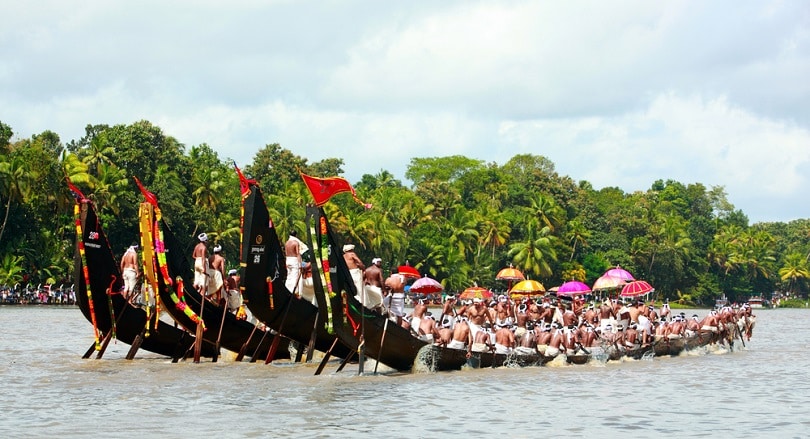Onam, the famous festival of joy and harmony is celebrated all over Kerala- the celebrations spanning over ten days. It’s that time of the year when the marked day on the calendar finally appears, and the air is ignited by zeal and infectious energy. It is a time for feasts, prayers, rangolis, gatherings and bringing out the popular ‘Onam sadya recipe’. The celebrations are marked by folk dances, martial arts forms, traditional games, feasts, and flowers.
If travellers were moths, then Kerala during Onam celebrations would be a blinding light- it attracts loads of wandering tourists each year and leaves them spellbound. The harvest festival is just the perfect opportunity for travellers to understand the rich cultural heritage of Kerala and have a lifetime experience of this grand spectacle.
Onam ranges from being a celebration of the harvest season to a legacy of an ancient legend. While one legend says that Onam is the observance of the day that Parasurama (an incarnation of Vishnu) created Kerala from the sea-bed by throwing his battle-ax into the waters; another remark on the golden rule of King Mahabali as the festival’s origin.
According to the latter tale, King Mahabali was a mythical king who ruled over Kerala. As the legend goes, the Gods in envy of King Mahabali’s popularity and power, conspired to destroy his reign. For this purpose, they sent Lord Vishnu to earth in the body of a dwarf Brahmin who ended Mahabali’s reign and sent him to hell. However, the King was granted one boon i.e. to visit his land and people once every year.
Hence, Onam is said to be the period when King Mahabali’s spirit revisits Kerala and the land’s people welcome his presence with joy and festivities.
Kerala leaves no stone unturned when it comes to celebrating this grand festival. All festivities are fused by a culture that is unique, distinctive and has a history of its own.
Location: Punnamada Lake, Alappuzha

Highlights: The famous snake boat race attracts thousands of tourists every year. It’s one of the most popular festivals of Kerala. Many boats participate under various categories in this festival. The event includes various performing artists, all kinds of boats adorned with decorations and the famous Nehru Trophy. The thunderous cheers of the audience and the mad energy of the festival is a one of a kind experience.
Location: Tripunithura, Ernakulam district, Kerala
Highlights: Athachamayam is a cultural celebration that provides visitors the rare opportunity to witness almost all the folk art forms of Kerala. Every year on the Atham asterism of the Malayalam month of Chingam (roughly August/September), Thripunithura, near Kochi, plays host to this famous ceremony which commemorates the victory of the Raja (King) of Kochi. There is also a splendid procession, which is accompanied by musical ensembles, elephants and a variety of folk-art forms.

The experience is truly memorable and unique.
Location: The folk art is mainly practiced in Thrissur district of Kerala. The best place to watch the show is at Swaraj Round, Thrissur on the fourth day of Onam, where Pulikali troupes from all over the district gather to display their skills. The festival attracts thousands of people to the Thrissur city, this time every year.

Highlights: Pulikali, literally translates to ‘play of the tigers’ and involves performances revolved around the theme of ‘tiger-hunting’. A very popular concept that originated from Kerala and has been continued in various other places, Pulikali dancers make use of vibrant paints on their bodies and manifest a mad energy in their performances that seek to fuse ‘man’ and ‘beast’ in an artistic way.
Onam is that time of the year when Keralites put their cooking spirits to action and give their taste buds a large treat. The Onam Sadya is a grand feast, a great bonding activity and a cultural highlight of Onam in Kerala.
The term Sadhya means banquet in Malayalam, and is basically a feast that consists of various vegetarian dishes. From Papadam to Curry and Sambar to Rasam- you name it, and the Sadya spread has it!

Be it the perfect Onam pictures or the rejuvenating festival vibes, the soothing aesthetic to the eyes or the fresh scent of flowers- Pookalams or flower arrangements are the answer to all of them.
‘Poo’ means ‘flower’ and ‘Kalam’ means artwork. Floral Rangoli or the ‘Onam Kolam’ is a very important part of the Onam celebrations. Arranging a Pookalam every day on floor is a ritual during the ten-day-long Onam festival. Various flowers and colours are used each day; a particular flower is dedicated to each day of Onam.

The traditional Ona-pookkalam usually consists of ten rings indicating the ten-day ritual during the ten-day celebrations of Onam which begins on Atham and ends on Thiru Onam in the month of Chingam. It is also said that the ten rings or the steps of the Pookalam represents the ten deities of the Hindu pantheon. The Onam Pookkalam is also considered a symbol for secularism.
The essence of Onam celebrations in Kerala is marked by such beautiful artworks along with the hearty celebrations. It indeed marks as a day that can be enjoyed by all- the young and the old, locals and tourists and many more.
Onam is a festival that is heartily celebrated all over the country and Kerala is one such place where the festival has a grand identity of its own. It marks that one day in the calendar when communities come together to immerse themselves in boat races, rangoli-making, and other bonding exercises. The diversities flourish in a special unity and joy becomes the sole mode of communication between people of various races and languages.

Please go back to portrait mode for the best experience